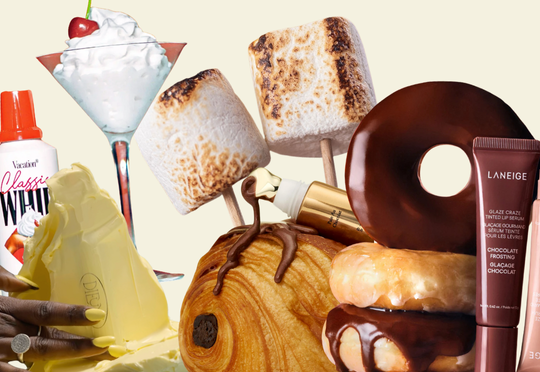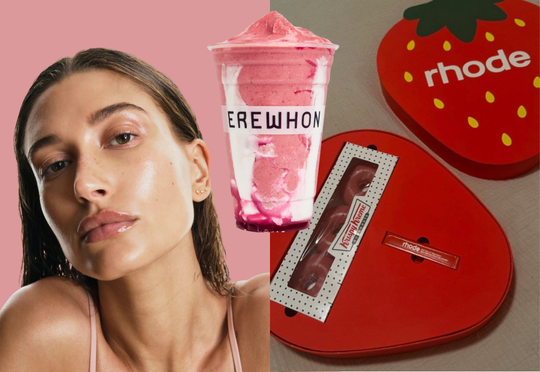Food as Luxury

If you're anything like us, chances are this summer your Sephora and Ulta carts were full of products billed as guava, souffle, glazed. It doesn’t stop here: your favorite fragrance notes these days are “sugared lemon,” “marshmallow,” “caramel.” Noticing a theme? The decade of decadence, all things edible and gourmande are in!
But it’s also a curious matter: why the heck is food, particularly ultra-sweet delicacies, the star of our beauty regime these days? Who wants donut glaze stuck on their lips or icing all over your face (seen the wedding cake-smash-as-abuse discourse lately?) or berry juice running down your chin and neck? Remember when smelling like food or having a grease stain was considered a point of shame, even insult?

What a phenomenon to consider, particularly as the real thing is often a sticky mess. But in reality, sales of gourmand fragrances are valued at $35 billion and the top-selling category of 2024 (source), and cosmetic and skincare trends are so intertwined that 2025’s top sweeping looks are “Guava Girl,” “Latte Look” or “Blueberry Milk nails,” which ironically are all trends the beauty space has seen before, just branded differently (“flushed,” “bronzed,” and “baby blue,” respectively). Why then are both industry and consumer-demand so oriented towards these morsels of goodness?
The answer is not a singular one, but rather rooted in generational marketing tactics, youth obsession, scarcity, dieting drugs and ultimately, culturally what we consider luxury these days (hint: it’s not Birkins or Rolexes, interestingly). Market researchers have been watching the spending habits of Gen Z, who now are between 29 and 16, and as this generation comes into their spending power (although 30% are reported to have more than $50k in credit card debt), the category they spend the most (besides rent + utilities)? Food.

As Vogue Business reported two years ago, $100 grocery hauls or the infamous $20 Hailey Bieber smoothie from Erewhon “coming out of the pandemic and into a recession, food has remained a status symbol for some price-sensitive Gen Zs, much like a luxury item or piece of music merch, experts agree.” New York Magazine even reported that some Gen Zs have second jobs to afford their Erewhon habit.

Why do we care that Gen Z is a spend-happy cohort, who are utilizing debt-leveraging “buy now, pay later” services like Klarna or Afterpay? Never forget the first rule of marketing: trends cycle around the young and youth culture. The formula looks a little like this: Youth=cool, cool is consumed, and thus youth is for sale. Thus, one tactic we’ve seen in the last few years is brands and marketing departments taking the signal to cross-pollinate consumer products with sought-after food flavors and purveyors. In beauty, this tack turned out: e.l.f. x Chipotle, Tarte x Dunkin Donuts, Glossier x Magnolia bakery, and of course, Rhode x Krispy Kreme, and just announced, a spicy lip collab with Tajin x Rare Beauty.

In 2023 Rhode x Krispy Kreme traded on Bieber’s “Glazed Donut” catch-phrase of ultra-dewy skin, with Rhode launching a Strawberry Donut lip peptide treatment; while in 2025, Rhode dropped its own Lemontini collection, further doubling down on the brand’s success with food-based collections. In fact, it’s not an overstatement to suggest that Hailey Bieber might be partly responsible for the food-as-luxury obsession, especially in the beauty industry.
From these collabs, what’s launched are a series of limited edition hero-products, like lip balms and oils, flavored or colored to the collab brand’s own best-selling food dish, usually a goody considered indulgent.

Industry consultants have noticed this turn to the calorics flavor-profiles in beauty, and weighed it side-by-side against the rise of GLP-1 usage, best known as Ozempic or Munjaro, and finding a connection (not a correlation!). With 12% of Americans are on semaglutides per a recent RAND study (source), the rise of food flavor products might have something to do with, what’s being coined the Ozempic effect, where folks either aren’t or simply can’t eat their favorite treats, and instead these scents signal pleasure without the guilt.

Food-flavored beauty products aren’t new—just think back to your middle school Watermelon Lip Smackers, or even the whole brand prop of Too Faced (why was chocolate-scented eyeshadow ever a thing?). Yet, this time around, it is different. With Rhode and K-Beauty leading the charge, food flavorings are no longer cheap or kitschy, but rather rarefied. The ultra-luxe fashion house, The Row, just began selling its own potato chips. (Luxury stunting at its finest.) Now cosmetics, skincare and fragrance pulling from elevated profiles, including hard-to-source “exotic” raw materials, signals of their specialness, devoid even of its source or origin, but rather its market positioning. Scarcity is, after all, the wings of desire.
Food, at the end of the day, is a finite resource and has a short lifespan. Food is fleeting, impermanent, and what’s more scarce, ergo luxury, than decaying beauty? Was that not the point of Maurizio Cattelan’s stunt at the 2022 Art Basel Miami Beach with his banana sculpture “Comedian” taped to the wall? The work became an internet sensation as a sharp critique, and participation, of luxury consumption. Same goes for beauty with guava, cherry, tonka—fruits here to be consumed or meet their fate… nectar rotten from neglect. In a contemporary era where everything really can be replicated or duplicated (have you seen our Dupe Culture post?), the bite of a fresh peach or snap of a just-picked apple or the snap of a Tencha leaf, that can only be made by nature, is real and distinct.
The natural world is quickly becoming the rarest thing of all. Is that not the final boss of luxury?

Since most of us globally now live in cities (source) and spend our days behind computers or production lines, we don’t actually engage in wild nature all that frequently. Could this swing towards food be a yearning towards the finest delights earth has to offer? The truth might be simpler than that (ahem, guava does smell delish), but we can’t forget our consumer habits are tied to larger cultural and societal mood shifts too. One standout shift is now that drugstore products sit in the traditional “mid-tier” pricing range, Beauty no longer is that surefire “attainable luxury” (lipstick index, anyone?). Could it be that this turn towards food is a move to beckon consumer desire and signal accessibility (since, in theory, nature provides food for everyone) in a crowded and uncertain beauty market? We see where it holds water, what say you?
What are your thoughts? Add a comment to start the conversation and don't forget to follow us @beautíMod and join our newsletter list to stay up to date on all the exciting content and conversations we have in store for you.


.png)
.png)
.png)
%20-%20tariff.png)



Comments (0)